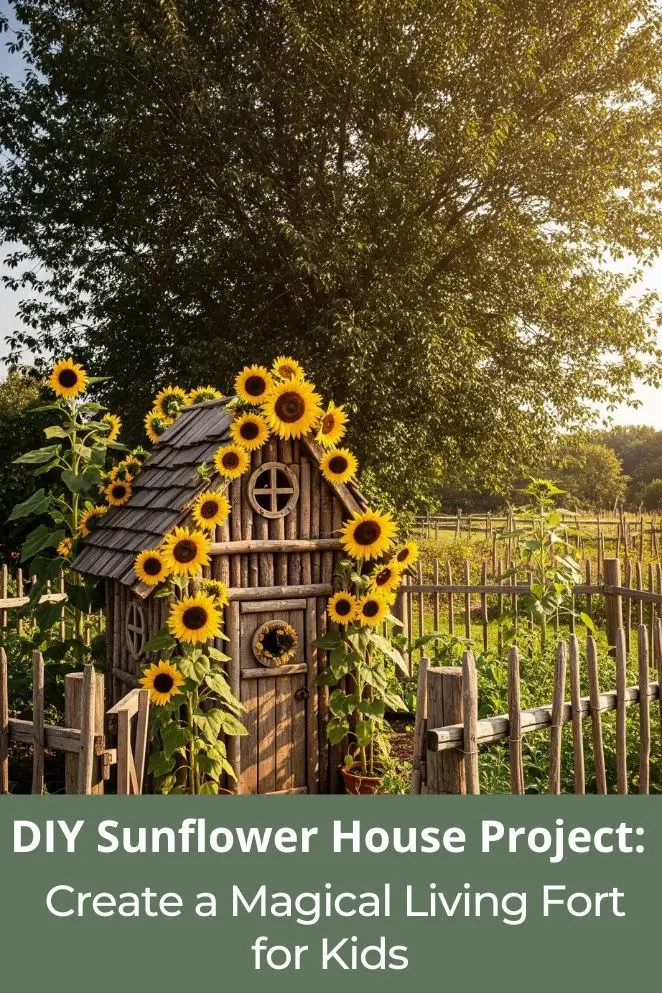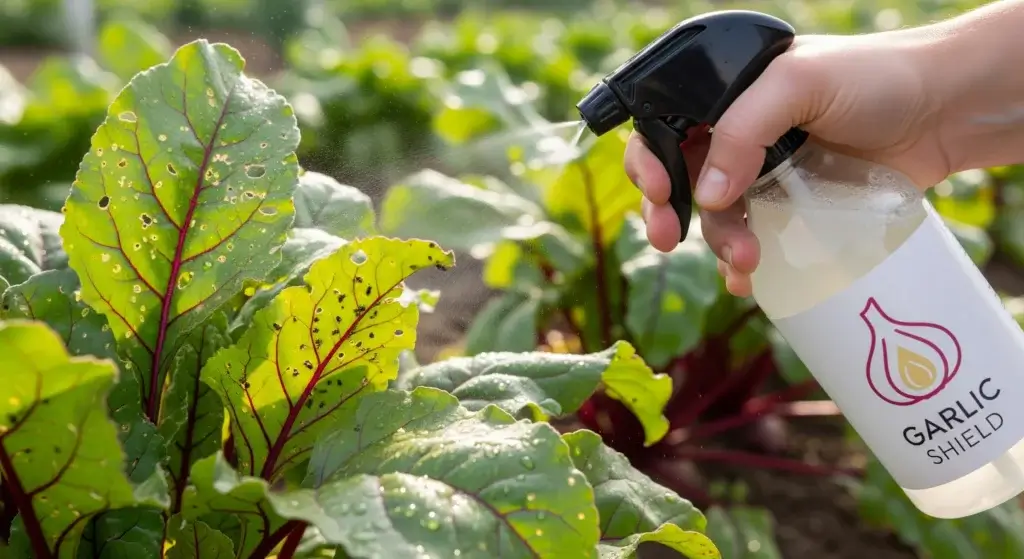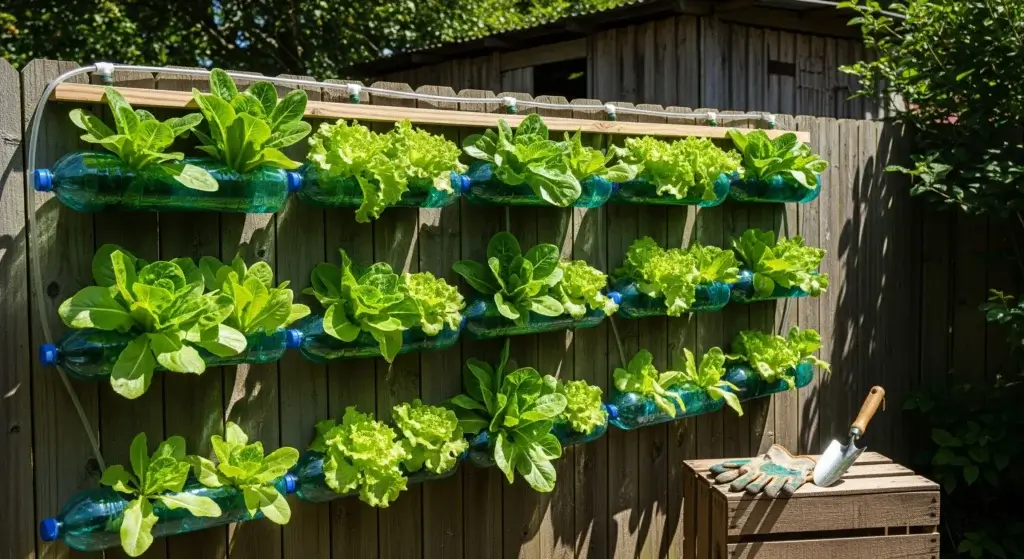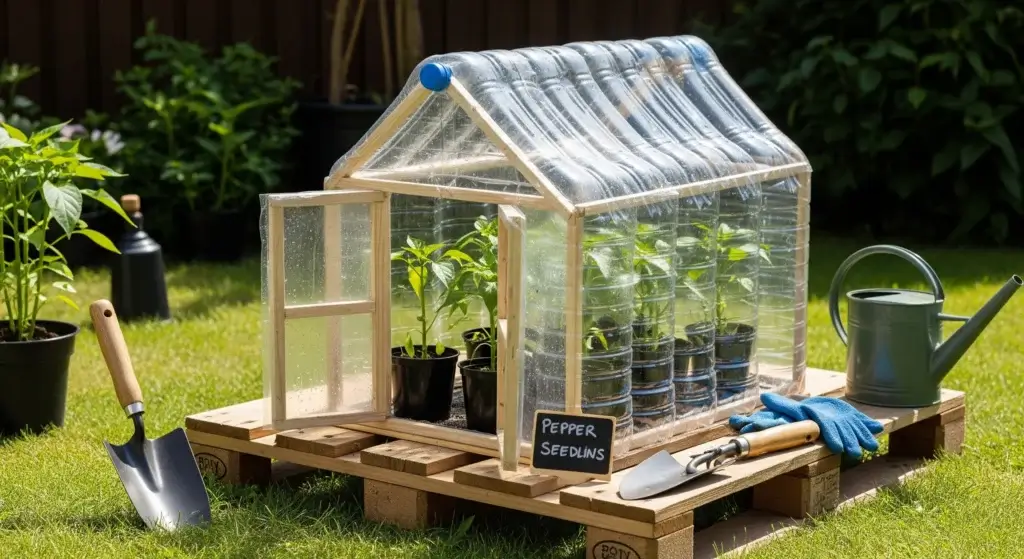
Imagine a hideout where sunflowers tower like castle walls, morning glories twist into colorful vines, and the whole place feels like it’s breathing magic.
That’s a DIY sunflower house—it’s not just a garden project, it’s basically your own secret base that grows out of the ground.
What Is a Sunflower House and Why Build One?
A sunflower house is exactly what it sounds like: living walls made from sunflowers that grow tall enough to carve out a secret hangout.
These giant blooms can get 8–16 feet tall and basically turn a patch of yard into a green fort where you can read, hide out, or build epic summer memories.
It’s caught on with teachers and parents because it blends real, hands-on plant science with play — no power tools, no heavy carpentry skills.
You plant, you water, you care a bit, and the house grows itself. Pretty wild for something that started from a packet of seeds.
Key Benefits of Sunflower Houses:
- Educational Value: Teaches plant life cycles, responsibility, and patience — but in a way that actually feels fun, not like homework.
- Physical Activity: Gets kids outside moving, climbing, and exploring instead of doom-scrolling.
- Wildlife Habitat: Brings bees, butterflies, and birds into the yard — nature’s guest list.
- Cost-Effective: Way cheaper than building a wooden playhouse; mostly seeds, soil, and time.
- Seasonal Magic: From tiny sprouts to towering flowers — the whole glow-up happens over months.
- Family Bonding: Perfect for a group project that actually creates memories instead of just chores.
Research from the National Gardening Association backs this up: kids who garden build stronger science skills and are more likely to eat fruits and veggies.
So a sunflower house isn’t just aesthetic flex — it actually turns gardening into play and learning at the same time.
Planning Your Sunflower House Design
Choosing the perfect location
Sunflowers are total sun addicts — they live for light. If they don’t get 6–8 hours of direct sun every day, they sulk and stay short.
So first thing: scout your yard like you’re picking a spot for a treehouse.
Morning sun is clutch, but the area should stay bright most of the day.
Location considerations:
- Sun exposure: Go for the brightest, least-shaded spot. Trees and fences are the enemy here.
- Soil drainage: Sunflowers hate soggy feet. If water puddles after rain, find a drier patch.
- Space requirements: You can technically do a mini 4×4 foot fort, but 6×8 feet gives way more hangout room.
- Wind protection: If your yard gets blasted with wind, tall stalks might topple. Pick a calmer zone.
- Accessibility: Don’t plant it in the far corner unless you like hauling watering cans every day.
- Safety: Double-check you’re not digging over pipes, septic tanks, or your neighbor’s property line.
Determining size and shape
The classic is a rectangle, but you can totally get creative depending on your space and vibe.
Think about who’s going to use it (little siblings, friends, maybe just you) and how much gardening you want to take on.
Popular design options:
- Rectangle: 4×6 or 6×8 feet — simple, solid, perfect starter size.
- Square: A cozy 6×6 makes an epic reading or chill spot.
- L-shape: More private, almost like having multiple rooms.
- Circle: Trickier to plan, but the “360 walls of flowers” effect is worth it.
- Maze design: Advanced move — connect multiple sunflower forts with winding pathways.
Essential Materials and Tools
Seeds and plant materials
Picking your sunflower squad is half the fun. These aren’t just flowers — they’re the beams and walls of your living fort, so choose wisely.
Primary sunflower varieties:
- Giant varieties: Russian Mammoth or American Giant — these monsters hit 12–16 feet, basically skyscrapers in plant form.
- Medium varieties: Autumn Beauty or ProCut series — 6–10 feet, still tall but easier to manage.
- Branching types: Autumn Fire or Sunrich series — instead of one giant head, they throw out multiple blooms, which means more color.
For a 6×8 foot house, you’ll want about 2–3 pounds of seeds so your walls grow thick and full (and to cover the fact that not every seed is gonna make it).
Pro tip: don’t cheap out on seeds. Get the good ones so they actually sprout and grow strong.
Companion Plants (Optional):
- Scarlet runner beans: Fast climbers that throw out red blooms — they’ll weave into the walls.
- Morning glories: Blue or purple vines that look like magic every morning.
- Sweet peas: Tiny flowers with a sweet smell that make the place feel cozy.
- Nasturtiums: Bright, edible blooms that also keep pests away — basically flowers with superpowers.
Tools and supplies
You don’t need a shed full of pro gear, just the basics to get the job done.
Essential tools:
- Garden hoe or cultivator — for breaking up the soil.
- Measuring tape — because “eyeballing it” leads to crooked walls.
- String line or flour — easiest way to mark your fort outline.
- Watering can or hose with a gentle spray — sunflowers don’t appreciate a power wash.
- Garden rake — to smooth the soil before planting.
- Hand trowel — your go-to for planting individual seeds.
Soil amendments:
- Compost or well-aged manure — 2–3 cubic feet, because sunflowers are heavy eaters.
- Organic or balanced fertilizer — keeps the plants from running out of steam halfway up.
- Mulch (straw, shredded leaves, or wood chips) — helps lock in moisture and keeps weeds in check.
Optional enhancements:
- Bamboo stakes or tomato cages — for giving young sunflowers a boost before they’re sturdy.
- Garden twine — for guiding beans or morning glories up the walls.
- Stepping stones — so you don’t stomp seedlings while exploring inside.
- Outdoor carpet or straw — turns the dirt floor into a comfy lounge spot.
Step-by-Step Planting Guide
Soil preparation
Think of this part as laying down the foundation for your fort.
Sunflowers aren’t divas, but they do way better in loose, well-draining soil with some extra nutrients mixed in.
Start prepping the dirt 2–3 weeks before you actually plant.
Preparation steps:
- Clear the area: Yank out grass, weeds, and random junk. Your sunflowers don’t like competition.
- Test soil drainage: Dig a foot-deep hole, fill it with water, and check back in 24 hours. If it’s still a puddle, you need a drier spot.
- Loosen soil: Dig or till 8–10 inches deep so the roots can spread.
- Add organic matter: Mix in 2–4 inches of compost or aged manure — basically plant fuel.
- Level and rake: Smooth it out so planting isn’t a chaotic mess.
- Mark boundaries: Use flour, string, or stakes to outline your “walls.” I once used sidewalk chalk because I couldn’t find string — it worked fine.
Seed planting technique
Timing matters. If you plant too early and it frosts, your seeds are toast.
Wait until after the last frost and when soil temps stay around 50°F (10°C). For most places, that’s late April to early June.
Planting process:
- Create planting lines: Use string or even a straight board to keep rows clean.
- Dig holes: 1–1.5 inches deep, 6 inches apart along the outline.
- Double row option: If you want beefy walls, plant two rows about a foot apart, staggering the seeds like bricks.
- Leave entry gap: Skip 2–3 feet where you want the door. No doorway = trapped fort.
- Plant corners first: Corner plants = structural pillars. Start there to frame your house.
- Water gently: Give them a good soak without blasting seeds out of the ground.
Pro tip: Always drop 2–3 seeds in each hole. Later, once they’re 4–6 inches tall, thin them down to the strongest plant.
That way if a seed ghosts you, you’re not left with gaps in your walls.
Watering and early care
The first month is make-or-break. Sunflowers need steady water while they’re putting roots down.
Think of it like training for a sport — you don’t skip the warm-up.
Watering schedule:
- Week 1–2: Light watering every day so the soil stays damp.
- Week 3–4: Every other day as roots dig deeper.
- Month 2+: Deep soak 2–3 times a week (more if it’s blazing hot and dry).
Early care tasks:
- Weed control: Pull weeds weekly — weeds are thieves that steal water and nutrients.
- Thinning: Once plants hit 4–6 inches, pick the strongest kid in the group and let them shine.
- Pest monitoring: Keep an eye out for cutworms, slugs, or birds trying to snack on seedlings.
- Support installation: If you live somewhere windy, add stakes so your sunflowers don’t faceplant.
Maintenance Throughout the Growing Season
Ongoing watering needs
Once your sunflower house is up and running, the plants don’t need babying the way seedlings do.
Mature sunflowers are tough — they can handle dry spells — but if you want monster stalks and flower heads the size of dinner plates, you gotta keep the water game strong.
When they hit 2–3 feet tall, switch to fewer but deeper waterings.
Mature plant watering:
- Frequency: 2–3 times a week in normal weather.
- Amount: About 1–1.5 inches total per week (rain counts).
- Method: Aim water at the soil, not the leaves — wet leaves = sick plants.
- Timing: Early morning is best; it’s like breakfast for plants.
Drought stress signs:
- Leaves sagging like they pulled an all-nighter.
- Bottom leaves going yellow and bailing.
- Flower heads looking smaller than expected.
- Blooms opening way too early like they’re rushing the show.
Fertilizing for maximum growth
Sunflowers are heavy eaters — think of them like teenage athletes.
If you feed them well, they’ll tower over you. If you don’t, you’ll end up with short, scrappy plants that look like they gave up halfway.
Fertilizing schedule:
- Planting time: Mix fertilizer into the soil before you even drop seeds.
- Month 1: When plants hit a foot tall, give them compost on the side like a snack.
- Month 2: Balanced liquid fertilizer every 2 weeks keeps them fueled.
- Pre-bloom: Right before flowers appear, switch to phosphorus-heavy fertilizer — it helps blooms pop.
Organic fertilizer options:
- Compost tea — basically plant Gatorade, every 2 weeks.
- Fish emulsion (diluted, or your yard will smell like low tide).
- Bone meal sprinkled around the base — root and flower booster.
- Aged chicken manure — powerful stuff, but don’t use it fresh unless you want to burn your plants.
Pest and disease management
Sunflowers are tough, but even they get unwanted visitors.
Catch problems early, and you’ll avoid full-on disaster.
Common pests:
- Birds: Cover seedlings at first, but once plants are tall, let the birds stay — they’ll snack on pests for you.
- Cutworms: Wrap seedling bases with little cardboard or foil collars. Think of it as armor.
- Aphids: Blast them off with water or let ladybugs handle them.
- Sunflower borers: If you see damage, cut it out right away before it spreads.
Disease prevention:
- Powdery mildew: Give your plants room to breathe; don’t soak their leaves.
- Downy mildew: Use well-draining soil and keep water at ground level.
- Rust: Pluck off infected leaves and improve airflow.
- Root rot: Avoid swampy soil — sunflowers don’t do soggy.
Troubleshooting Common Problems
Growth issues
Slow or poor germination:
- Cause: Soil that’s too cold, old or low-quality seeds, or soil that’s way too wet.
- Solution: Wait until the soil warms up, buy fresh seeds, and fix drainage so the seeds don’t drown.
Stunted growth:
- Cause: Trash soil nutrition, not enough sunlight, or plants packed like sardines.
- Solution: Feed them with fertilizer or compost, move the house to a spot with at least 6 hours of sun, and thin crowded areas so the survivors can grow big.
Weak or falling plants:
- Cause: Roots didn’t develop, wind whipped them, or the soil is junk.
- Solution: Deep-water so roots go down, stake the plants for support, and add organic matter to the soil so it actually holds nutrients.
Pest problems
Bird damage to seeds:
- Prevention: Throw on row covers while seeds are tiny and vulnerable.
- Management: Accept that wildlife is part of the deal—cover early, and once stems are tall, birds usually stop wrecking the walls.
Insect damage:
- Identification: Learn who’s helpful (hello, ladybugs) and who’s not.
- Treatment: Use targeted organic controls—blast aphids with a hose, invite predators, or use soap sprays—don’t nukes-everything pesticides unless you want to kill the good bugs too.
Weather challenges
Drought stress:
- Prevention: Mulch to lock in moisture and follow a deep-watering routine.
- Recovery: Don’t freak and drown them — gradually increase deep watering so roots rebuild without shocking the plants.
Wind damage:
- Prevention: Plant in a sheltered spot or put stakes in early so stalks have backups.
- Repair: Prop up battered plants, and if a stem is totally snapped, yank it and replant if needed.
Conclusion: Growing More Than Just Flowers
A DIY sunflower house isn’t just a garden project — it’s like planting pure childhood magic.
From dropping seeds in the dirt to watching them tower over your head, every step is part science experiment, part adventure.
I still remember marking my height against the stalks every week like it was a competition — and the sunflowers always won.



